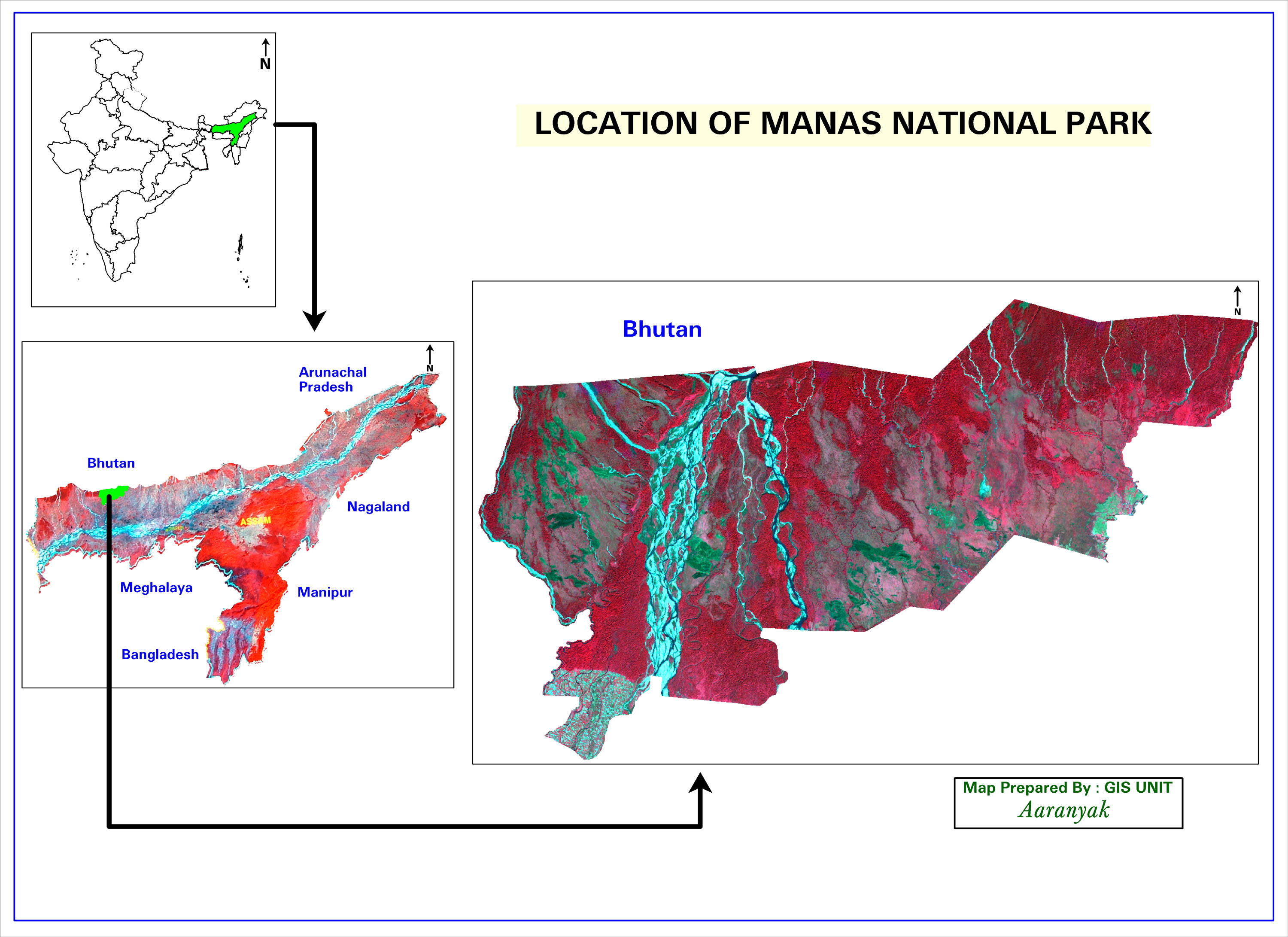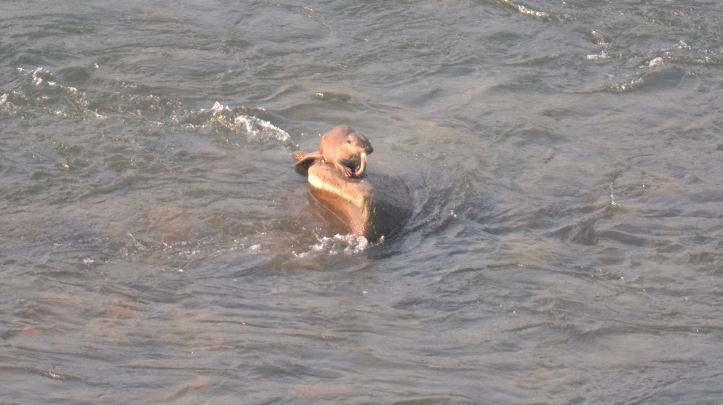IUCN/SSC Otter Specialist Group Bulletin

©IUCN/SCC Otter Specialist Group
Volume 37 Issue 3 (November 2020)
Citation: Sinha, A, Devi, N and Potter, AB (2020). Sighting of a Smooth Coated Otter Lutrogale perspicillata in Manas National Park, Assam, India. IUCN Otter Spec. Group Bull. 37 (3): 136 -139
Sighting of a Smooth Coated Otter Lutrogale perspicillata in Manas National Park, Assam, India
Alolika Sinha1*, Nilakshi Devi2 and Arjun B. Potter3
1Aaranyak, 13 Bishnu Rabha Path, Tayab Ali Byelane, Beltola Tiniali, Guwahati-781028, Assam, India. Email:: sinha.alolika@gmail.com; alolika@aaranyak.org (*Corresponding Autbor)
2Bar-Azara, Nalbari-781335, Assam, India
2Department of Ecology and Evolutionary Biology, Princeton University, 106a Guyot Hall, Princeton,
NJ, USA 08544
(Received 20th December 2019, accepted 12th January 2020)
Abstract: The Smooth-coated otter (Lutrogale perspicillata) is a vulnerable mustelid which occurs in wetlands and in low-lying areas. The species was once common in the floodplains of Assam, India, but it is now mostly restricted to protected areas in this region. Here, we report the sighting of this species in Manas National Park (MNP), Assam. The otter was found in the shallow waters of Beki River, with rocky substrate. This note confirms the occurrence of the species in MNP with photographic evidence.Keywords: Smooth-coated otter, Photographic evidence, Beki River
The Smooth-coated otter Lutrogale perspicillata mostly occurs in protected areas in South and Southeast Asia, inhabiting the wetlands and low-lying areas (de Silva et al., 2015; Hussain et al., 2018). Once common, this species is currently categorized as Vulnerable (de Silva et al., 2015), owing to an estimated population decline by 30% in the last three decades (Pacifici et al., 2013). It is listed in CITES Appendix II.
The Smooth-coated otter population is comparatively secure in areas where it geographically overlaps with the umbrella species such as Tigers Panthera tigris, One-horned Rhinoceros Rhinoceros unicornis in India (Hussain et al., 2018). In northeastern India, it occurs in all the eight states, including the northern part of West Bengal, though the present distribution is patchy (Choudhury, 2013). Historically, this otter was abundant in the Brahmaputra and Barak river valleys in Assam. However, the species has become rare in the region, except in the Kaziranga National Park (Choudhury, 2013) where it can still be seen in good numbers.
In Manas National Park (henceforth Manas), located in the northeastern state of Assam in India (Fig. 1), the species has been reported to occur, but no photographic evidence has been recorded in recent times (Lahkar et al., 2018). The Park was subjected to a long period of armed conflict from the late 1980s till the early 2000s. This resulted in the decline of many species, habitat degradation and destruction of park infrastructure (UNESCO, 2005). Since the formation of Bodoland Territorial Council (BTC) in 2003, peace and governance has been restored in the area, and on-ground conservation action has resulted in the recovery of many species (Goswami and Ganesh, 2014; Lahkar et al., 2018; Sinha et al., 2019). Currently, ecological studies are being conducted on a number of species of conservation concern. However, these studies focus mostly on large mammals, with comparatively little attention is paid to the small mammals of the park. In this short communication, the authors present a sighting and photographic record of the Smooth-coated otter in Manas.
On 23 January 2019, during a visit to the central range of the park (Bansbari), the authors observed an animal’s presence on a rocky surface of the Beki River (26°46'58.76"N, 90°57'26.09"E) that flows through the park. On careful observation using Nikon Monarch 8 X 42 binoculars, we identified the species as an adult Smooth-coated otter (Fig. 2). The animal was identified on the basis of its size and from its sleek grey-brown coat with paler grey underside (Menon, 2014). It was observed at 1456 h, for a duration of approximately four minutes. Since this species is known to live and hunt in groups (Hussain and Choudhury, 1997), we scanned carefully for other individuals, but did not find any. The otter was swimming underwater against a strong current, slowly moving upstream. Every 10 seconds or so, the otter would breach the water’s surface in the direction of travel before diving back underwater. During each leap, much of the otter’s body cleared the water. After a few dives, the animal caught a fish, brought it to the surface and was seen feeding on it on a rock. It was still feeding, when the observation ended.
Where the otter was sighted, the Beki River is a high gradient stream with a rocky bottom and a channel width of approximately 150 meters. The banks of the river were rocky with grassland vegetation. The left bank was a forested hillside, from which the observations were made. The right bank was a sandy floodplain covered with grassland and woodland dominated by red silk-cotton trees Bombax ceiba. The altitude was 95 meters above sea level. The otter’s location was less than half a kilometer from the border with Bhutan.
Previous sightings of the Smooth-coated otter in Manas have all been anecdotal. During a major camera-trap survey in 2016-17, no otter species were detected (Lahkar et al., 2018). Goswami and Ganesh (2014) mentioned a direct sighting of the Smooth-coated otter in Manas during their survey in 2008, but did not provide any further details such as group size, location and time of sighting. One of the authors (AS) has been working in the park for several years and has sighted the species only thrice (including the present sighting). The author has seen a group comprising of three individuals in a small river in the eastern range of the park (Bhuyanpara, 26°44'3.98"N, 91° 4'51.08"E) on 17 February 2016. When observed, the group was seen hunting but fled away on seeing her. On another occasion, ND has sighted a small group of the otter in a river (26°41'45.80"N, 91° 0'36.11"E) in the central range in February, 2018. AS has also seen the otters in this area of the park in 2017. During opportunistic discussion with the forest guards, and other researchers, they mentioned about the presence of otters in the park. They described that they had seen otters occurring in the wetlands in small groups (3-4), but could not confirm the species. Reportedly, an Asian small clawed otter Aonyx cinerea was rescued from a fishing net downstream of the Beki River, outside the boundary of Manas by a team of forest department and IFAW-WTI. This note presents the photographic evidence of the occurrence of Smooth-coated otters in the park. Further ecological studies can establish the current distribution status of the species in the park and its conservation needs.
Acknowledgements: The authors are grateful to the Assam Forest Department, Manas Directorate and Aaranyak for providing all the support and cooperation. We are also grateful to GTAD, Aaranyak for providing us with the map. We thank Dr. Himanshu Shekhar Palei for helping us with the identification of the species.
REFERENCES
Choudhury, A. (2013). The Mammals of Northeast India. Gibbon Books, India and The Rhino Foundation for Nature in NE India.
de Silva, P., Khan, W.A., Kanchanasaka, B., Reza Lubis, I., Feeroz, M.M., Al-Sheikhly, O.F. (2015). Lutrogale perspicillata. The IUCN Red List of Threatened Species 2015: e.T12427A21934884. http://dx.doi.org/10.2305/IUCN.UK.2015-2.RLTS.T12427A21934884.en. Downloaded on 30 November 2019.
Goswami, R., Ganesh, T. (2014). Carnivore and herbivore densities in the immediate aftermath of ethno-political conflict: The case of Manas National Park, India. Trop. Cons. Sc. 7(3): 475-487.
Hussain, S.A., Badola, R., Sivasothi, N., Basak, S. (2018). Smooth-coated Otter Lutrogale perspicillata. In Duplaix, N., Savage, M. 2018. The Global Otter Conservation Strategy., IUCN/SSC Otter Specialist Group, Salem, Oregon, USA, pp. 26-33.
Hussain, S.A., Choudhury, B.C. (1997). Status and distribution of Smooth-coated otter Lutra perspicillata in National Chambal Sanctuary. Biol. Cons. 80: 199-206.
Lahkar, D., Ahmed, M.F., Begum, R.H., Das, S.K., Lahkar, B.P., Sarma, H.K., Harihar, A. (2018). Camera-trapping survey to assess diversity, distribution and photographic capture rate of terrestrial mammals in the aftermath of ethno-political conflict in Manas National Park, Assam, India. JoTT 10: 12008-12017.
Menon, V. (2014). Indian Mammals: A field guide. Hachette Book Publishing India Pvt. Ltd.
Pacifici, M., Santini, L., Di Marco, M., Baisero, D., Francucci, L., Grottolo Marasini, G., Visconti, P., Rondinini, C. (2013). Generation length for mammals. Nat. Cons. 5: 87-94.
Sinha, A., Lahkar, B.P., Hussain, S.A. (2019). Current population status of the endangered hog deer Axis porcinus (Mammalia: Cetartiodactyla:Cervidae) in the Terai grasslands: a study following political unrest in Manas National Park, India. JoTT 11(13): 14655-14662
UNESCO Report. (2005). Report on the UNESCO-IUCN Mission to the Manas World Heritage site, India
Resume: Observation de la Loutre à Pelage Lisse, Lutrogale Perspicillata, dans le Parc National de Manas, Assam, en Inde
La loutre à pelage lisse (Lutrogale perspicillata) est un mustélidé vulnérable qui est présent dans les zones humides et les zones de basse altitude. L'espèce était autrefois commune dans les plaines inondables de l'Assam, en Inde, mais elle est, actuellement, limitée principalement aux zones protégées de cette région. Nous rapportons, ici, l'observation de cette espèce dans le Parc National de Manas (MNP) de l’Assam. La loutre a été trouvée dans les eaux peu profondes de la rivière Beki au substrat rocheux. Cette note confirme la présence de l'espèce dans le MNP avec des photos preuves à l’appui.
Revenez au dessus
Resumen: Avistaje de una Nutria Lisa Lutrogale Perspicillata en el Parque Nacional Manas, Assam, India
La nutria lisa (Lutrogale perspicillata) es un mustélido vulnerable que vive en humedales y áreas bajas. La especie era antes común en las planicies de inundación de Assam, India, pero ahora está mayormente restringida a las áreas protegidas de esta región. Aquí, informamos el avistaje de esta especie en el Parque Nacional Manas (MNP), Assam. Encontramos a la nutria en aguas someras del Río Beki, con sustrato rocoso. Esta nota confirma la ocurrencia de la especie en MNP, con evidencia fotográfica.
Vuelva a la tapa

